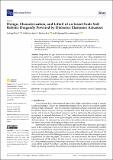Design, Characterization, and Liftoff of an Insect-Scale Soft Robotic Dragonfly Powered by Dielectric Elastomer Actuators
Author(s)
Chen, Yufeng; Arase, Cathleen; Ren, Zhijian; Chirarattananon, Pakpong
Downloadmicromachines-13-01136-v3.pdf (17.52Mb)
Publisher with Creative Commons License
Publisher with Creative Commons License
Creative Commons Attribution
Terms of use
Metadata
Show full item recordAbstract
Dragonflies are agile and efficient flyers that use two pairs of wings for demonstrating exquisite aerial maneuvers. Compared to two-winged insects such as bees or flies, dragonflies leverage forewing and hindwing interactions for achieving higher efficiency and net lift. Here we develop the first at-scale dragonfly-like robot and investigate the influence of flapping-wing kinematics on net lift force production. Our 317 mg robot is driven by two independent dielectric elastomer actuators that flap four wings at 350 Hz. We extract the robot flapping-wing kinematics using a high-speed camera, and further measure the robot lift forces at different operating frequencies, voltage amplitudes, and phases between the forewings and hindwings. Our robot achieves a maximum lift-to-weight ratio of 1.49, and its net lift force increases by 19% when the forewings and hindwings flap in-phase compared to out-of-phase flapping. These at-scale experiments demonstrate that forewing–hindwing interaction can significantly influence lift force production and aerodynamic efficiency of flapping-wing robots with passive wing pitch designs. Our results could further enable future experiments to achieve feedback-controlled flights.
Date issued
2022-07-18Department
Massachusetts Institute of Technology. Research Laboratory of Electronics; Massachusetts Institute of Technology. Department of Electrical Engineering and Computer SciencePublisher
Multidisciplinary Digital Publishing Institute
Citation
Micromachines 13 (7): 1136 (2022)
Version: Final published version